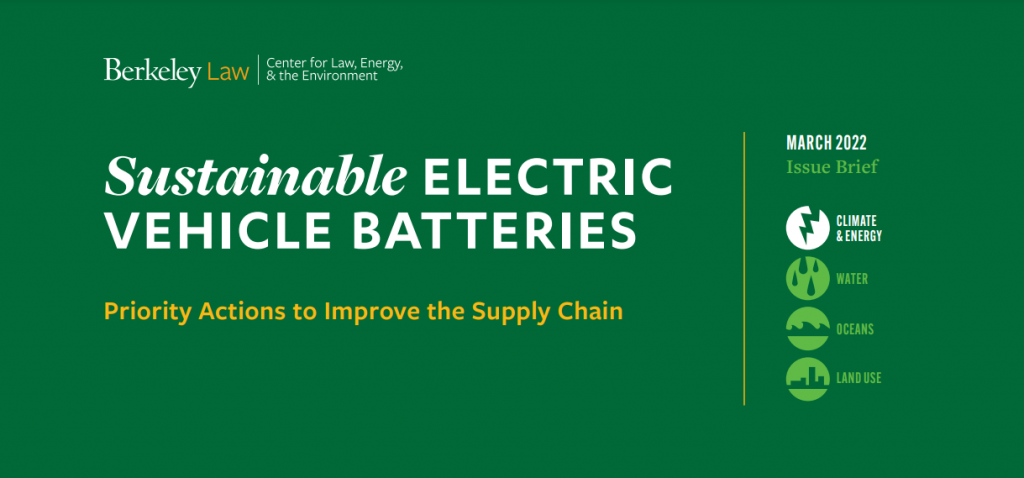Responsible EV Batteries
Legal Planet: Environmental Law and Policy 2022-04-11

On April 4, the Intergovernmental Panel on Climate Change (IPCC) released the mitigation chapter of its Sixth Assessment Report (view the full report here). The report’s diagnosis is stark—the window to address climate change is narrowing, and more quickly than we realized. Governments need to deploy mitigation actions rapidly to address the scale and urgency of the crisis, and must implement a diverse portfolio of actions to tackle emissions from different sectors.
Transportation is the single greatest source of emissions in California and the US and a leading source of emissions worldwide. While appropriate strategies to cut transportation emissions may vary by country, the IPCC report notes that “electric vehicles powered by low emissions electricity offer the largest decarbonisation potential for land-based transport, on a life cycle basis” (Summary for Policy Makers, page 41). Behavioral change and wide-scale adoption of public transit or alternative transportation options can offset some demand; however, a huge increase in demand for batteries is inevitable, particularly in car-dependent regions (like much of California and the US). It is vital that policymakers and industry leaders craft this transition in an environmentally and socially responsible manner.
Building the mineral supply chain needed to deploy electric vehicles (including cars, buses, bicycles, and scooters) on a massive scale, if done without planning and engagement, could risk environmental and social harm to communities in countries where minerals are mined and processed (and, to a lesser extent, manufactured and later recycled) into usable batteries. A typical EV battery requires an array of minerals, including lithium, cobalt, and nickel, among others. Many of the locations with the richest supply of these resources are in countries with histories of governance challenges and exploitation of local and indigenous communities for resource extraction.
Governments, companies, communities, and civil society organizations face a daunting challenge: drive electric vehicle adoption and battery production forward at a pace commensurate with the need outlined in IPCC’s latest report, while ensuring—as the extractive sector has often failed in the past—the highest level of protection for human rights, community consent and input, and the environment.
To address this challenge, CLEE convened experts in December 2021 to discuss opportunities for increased advocacy and collaboration and to identify policy challenges and opportunities. Our new policy brief highlights key solutions including battery labeling standards, mining law reform, and increased technical assistance. Convening participants identified opportunities for advocates and industry leaders to improve international coordination, advocacy efforts, community engagement, and circular economy practices. Key barriers and solutions include:
- Barrier 1: Poor supply chain governance. Policymakers lack comprehensive and targeted governance strategies to minimize harm at each stage of battery material’s lifecycle.
- Example solution: Strengthen binding measures. Enhancing binding legal and regulatory measures would support enforcement while promoting global consistency around supply chain sustainability expectations.
- Barrier 2: Lack of attention to community needs and human rights. Current mineral supply chain systems too often fail to incorporate the rights, priorities, and needs of vulnerable groups and communities impacted by mining and processing activities, as well as the transportation activities that support movement of minerals (such as additional pollution from construction and transportation vehicles, or noise from new roads).
- Example solution: Bolster technical assistance and funding. Advocacy organizations, philanthropic organizations, research institutions, and governments could allocate more resources towards supporting human rights and community priorities through funding and technical assistance.
- Barrier 3: Lack of incentives for circular economy practices and demand reduction. A lack of emphasis on circularity, and on strategies to minimize the projected demand for new battery materials while still achieving transportation decarbonization, poses a barrier to a sustainable supply chain that promotes human rights and environmental protection.
- Example solution: Set recycled content targets. Implementing targets for incorporating recycled materials into new battery cells could promote market demand for recycled materials over newly extracted materials.
For a full set of solutions and to learn more, see our policy brief here.
The post Responsible EV Batteries appeared first on Legal Planet.